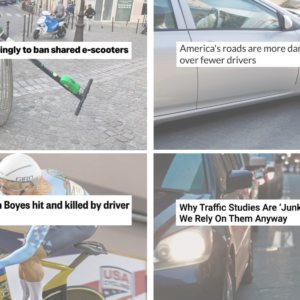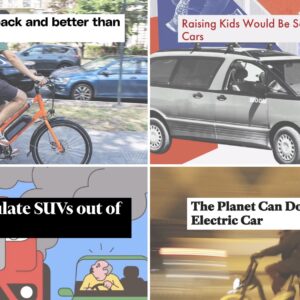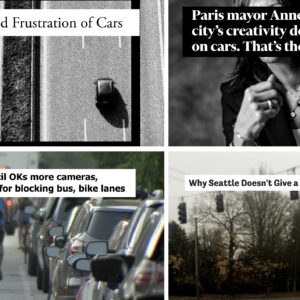Welcome to the week. Here are the most notable stories our writers and readers have come across in the past seven days…
**This week’s roundup is sponsored by the Cannon Beach Fat Tire Festival, an event on May 12-14th that promises a beach bike ride, a self-guided ride, a scavenger hunt to discover hidden treasures and tasty treats, and a bonfire with fat bike games and activities.**
Move over NFL, the NCL is here: I was already very excited about the new National Cycle League, but after learning how many investors in the league are pro football players, I think it might be the most important story in cycling right now. (USA Today)
Inaccessible bus stops are a crime: When a safe streets advocate was hit by a car while bicycling and paralyzed, he became radicalized around the issue of ADA accessibility and his work to make bus stops better even got him thrown in jail. (Streetsblog USA)
Bikeways for whom? In order to make bike networks work for disabled cyclists, planners need to talk with riders and get creative. (Bike Radar)
Haters in Hollywood: For many years advocates have grumbled about how bicycle riders are represented in the movies and now a popular podcast has broken down the issue. (The War on Cars Podcast)
Dealing with deadbeat drivers: If we want to ride our system of inequities when it comes to traffic safety, we must work even harder to use technology and other forms on non-police enforcement or the outcome will just be more deaths and injuries. (Bloomberg)
Adult trike guide: Three-wheeled bikes are all the rage because of how they expand cycling to a wider audience. Learn more about them in this handy introduction. (Momentum Mag)
Kotek and street racing: Oregon Governor Tina Kotek has said “yes” to most of Portland Mayor Ted Wheeler’s request for help on street safety issues like illegal speed racing and drunk driving. (The Oregonian)
Induced demand is real: A $600 million expansion of Highway 101 in California’s Bay Area area has done nothing but add more cars and more congestion to the system. (Streetsblog SF)
Nah: Governor Kotek has thrown a wet blanket on ODOT’s wet dream of $1 billion in bond revenue to pay for Oregon’s portion of the Interstate Bridge Replacement Program project. (Oregon Capitol Chronicle)
Heavy parking: Will cities pay millions to beef up parking garages to withstand the weight of EV cars? I sure hope not. (The Drive)
Thanks to everyone who shared links this week.








Thanks for reading.
BikePortland has served this community with independent community journalism since 2005. We rely on subscriptions from readers like you to survive. Your financial support is vital in keeping this valuable resource alive and well.
Please subscribe today to strengthen and expand our work.
BP wishful thinking?
Kotek herself:
I’ve given up all hope that POregon will begin to address ecocide and its human sacrifice zones,
US Highway 101 goes along the Peninsula. It’s not in California’s East Bay area.
It would be congested with induced demand in either location.
thanks. I’ve edited it. Sorry for the mistake.
It would be congested even without induced demand given that it probably offers a better route for many drivers.
Minor note – Highway 101 is not in the east bay, it’s on the peninsula. Interestingly, that part of the bay area is both the richest and least well served by transit. Caltrain is really a lot worse than BART it terms of utility, and there isn’t really good service to speak of in San Mateo county at all, especially south of SFO.
I thought people liked Caltrain, at least commuters with predictable schedules. There are quite a few stations in San Mateo county, I count 13.
They also just got a bunch of money to finish the electrification project which will increase frequency of service and speed.
It only really works for people commuting to either end, but mostly to San Francisco, and that has declined significantly with WFH. The entire peninsula is sprawly suburbs, which doesn’t lend itself to high mass transit ridership.
Great find on the adult trike story! I forwarded it to my father who loved bicycling, but can’t really do it now due to age. An electric trike is perfect for just getting outside and enjoying the world, plus the pics in the article are happy. My brother is in a wheelchair and I’m very glad to see a focus on biking and community transportation articles that are more inclusive!
Not a delta or tadpole trike in the entire article?
There are so many terrible Trimet bus stops. For example, Canyon Road off Hwy 26, down the hill towards Beaverton. It’s a fast, 4 lane road without sidewalks, yet it has bus stops. How to people get to and from the bus stops? Seems like a disaster waiting to happen.
Portland has a program for putting in curb cuts, sometimes replacing old ones that don’t quite meet the current specifications. That’s great. It probably took a lawsuit to make that happen.
Meanwhile we have bus stops that drop off in a ditch, and the city allows new development without a safe passage for pedestrians? I’ve seen a person with a powered chair crossing a freeway overpass on the street. At the time it didn’t occur to me that it was activism.
Any time the PBOT commissioner appears in public, maybe ask them about SW Gibbs? That’s got to be an ADA issue. Whatever the city did to wriggle around it was BS.
I recently had a friend be the victim of a very violent crime. He has had a lot of medical bills as a result, but luckily much of what his insurance has not covered has been picked up by a state administered crime victims fund that he qualified for. In Washington this is administered by the same folks who do unemployment insurance but he told me that his understanding is that these state level funds are mandated by the federal government. I wonder if Mr. Hardy Braz could benefit from a similar program in his state. We also need to be doing a lot more to make sure that everyone operating a motor vehicle is licensed and carrying a reasonable amount of insurance, the minimums in Oregon are WAY TOO LOW. 50k doesn’t go far when you are permanently injured by someone.
It doesn’t cost that much to double your liability coverage, and for a person who has any assets it’s a smart thing to do. Even 100k isn’t a lot of money if someone is seriously injured.
“If people are drag racing on your streets, those streets are horribly designed.” —Charles Marohn
My nearby main street recently received speed bumps. Many are slowing down, but a surprising number are driving the same high speeds as before. They just don’t care about what it does to a car. Non-scientific, but the few where I saw the driver were younger, teens & 20s.
Though not drag racing, people are still speeding even with the speed bumps. 🙁
Why is a new highway lane considered a failure for being well used? If a new bike lane was jam packed with cyclists, I don’t think you’d label it a failure
$600 million was spent and there is still congestion when the stated reason for the project was to “reduce traffic congestion”. How is that not a failure? That is not sustainable no matter what way you look at that.
The article also points out several other negative externalities as a result of this project.
Induced demand tends to work over long time periods; new roads open up new areas for development, for example, generating new demand for the road as new stuff is built. If a road fills up more or less instantly, that’s existing demand at work.
If the new facility is pulling vehicles off other, less efficient facilities, then the combined externalities may not be all that significant, or even positive.
Not how induced demand works. The amount of driving is not a fixed quantity, because people can choose to do it or not. If driving is inconvenient, then some people will walk, bike, take transit, or just make fewer trips overall. And if driving is cheap and easy, people will do that more. Big shocker, I know.
https://www.vox.com/2014/10/23/6994159/traffic-roads-induced-demand
People who want to drive but don’t because the cost is too high may well do so if the cost is reduced, filling expanded roads with “new” traffic. But this demand was already there, unsatisfied. It is not “induced” or created by a new facility. Inducing new demand works on longer time horizons.
I’m not sure whether satisfying existing demand for travel should be considered a public good or not, but it does seem to be at least part of why we build roads in the first place.
It is interesting to me that it is often the same people who (rightfully) reject trying to build our way out of transportation shortages that most strenuously embrace the strategy when it comes to housing, which has its own form of induced demand.
This is a bit of hair splitting. It doesn’t really matter if the demand is induced or latent, either way the roadway capacity is used by it. If someone takes an extra trip to the store because a new highway project makes it more convenient to drive to Target in the burbs rather than walk to the local store was that trip induced by the highway? Or do consumers just naturally want to drive out to big box stores for their shopping needs?
Moreover, does the distinction on if this trip is “induced” or “latent” even really matter? No. The trip is bad for the local economy is a huge number of ways. It means $ are flowing to a mega-corporation in Minnesota, rather than staying with a local merchant. It means that more fossil fuel emissions are being created and imposed on the local population. It means that the government/taxpayer will be left to pick up the slack when the mega-corporation inevitably cuts wages and benefits – forcing folks onto welfare while still working.
People could just as easily want to travel to avoid shopping at Target, and instead visit a locally owned alternative to help keep their money in the local economy.
That is not really how things typically play out though. The Walmart Effect – typified by big box retailers exerting downward pressure on both wages and prices makes typical local business shopping less competitive. And since these stores are primarily located in car-centric suburban areas, the effect is also usually more traffic.
People can (and do) chose to shop locally still. But local shopping means just that – local. It means walking, biking, or taking a short drive to the neighborhood store. Why would I drive cross town on a highway to get to a small store with higher prices when I could walk to an equivalent store? When people choose to drive for their shopping, etc. it means going to places where they can do a lot of shopping at once, and get good (perceived) value. This overwhelmingly favors the Costco, Walmart, Target experience at the expense of the local main street.
If you live in the California suburban wasteland, a locally owned store might be many miles away. Here in Portland, I sometimes shop at People’s. People travel from all over the Portland region to shop there, despite many closer and cheaper alternatives, so the dynamic you describe is hardly universal, and mostly feels stereotypical and suppositional.
But we’re straying pretty far from the topic, and, as usual, our apparent disagreement is essentially nuance over a more fundamental agreement, so I’ll let you have the last word if you want it.
You never notice nuance do you? Lets build out of transportation shortages, absolutely! But with buses/trains/bikes/walkable environments. Same with housing, lets not try to build our way out of housing with detached single family homes the same way we shouldn’t build out of transportation shortages with more cars. There are so many negative externalizations to both of those and both are flat out unsustainable.
I don’t think building bigger roads or lots of market rate housing is good for our region. Both just end up inducing more of the growth that they purportedly address.
“People who want to drive but don’t because the cost is too high may well do so if the cost is reduced, filling expanded roads with ‘new’ traffic…” Congratulations, you just explained induced demand. “Demand” in this context means the number of people willing to drive at any given time. Claiming it doesn’t meet someone’s personal definition of “induced” is pure sophistry.
The reason infill housing doesn’t generate the same kind of induced demand as highway expansion is that people cannot generally occupy as many housing units as they want at taxpayer expense. Driving on highways is free, hence the word “freeway”. Housing is not free. There’s the difference.
This is extrapolation fallacy. The amount of time people are willing to spend driving is finite and at some point it’s completely possible for road supply to meet demand
At that point all roads will be 20 lanes wide and construction and upkeep will cost 90% of public budgets, which will be slashed due to all the productive land being used for more roads. Not a society I want to live in.
The road network as a whole has a greater capacity, and that will induce demand until the “less efficient facilities” are back to what they were pre-widening. There is no way to build out of car congestion and I will not debate this fact with you.
Exactly, because cycling is social and fun. I enjoy seeing my fellow citizens out there on bikes. Biking in a huge group is incredibly satisfying and fun. Driving in traffic sucks, and no one enjoys it.
Highway traffic is considered a failure by the people interacting with the facility. I personally don’t really care if there’s a traffic jam on the highway, since I don’t use it. I do care when the “solution” to it involves spending $1 billion on something that is exceedingly unlikely to solve the problem they are spending $1 billion on. That money would be better spent on literally almost anything else – building social housing, bike paths, improving rail infrastructure, paying bus drivers more, hanging the wires for a trolleybus service, the list is very long.
Maybe for an event, but then driving in that context might be fun too.
When you’re just trying to get somewhere, riding on a crowded facility sucks (think Springwater on a sunny Saturday afternoon, where you need to slow down constantly to wait for a chance to pass a group of pedestrians). Heck, even walking in those conditions sucks (impatient cyclists trying to squeeze past makes even a pleasant stroll stressful).
Luckily, for the most part, Portland has successfully implemented a program of “reduced demand” that leaves me with ever-improving bike facilities with very few others using them.
Given that drivers licences have barcodes on the reverse, I wonder how difficult it would be to have an ignition interlock system that requires the driver to scan their license before the car will start. I’d probably even install one for my own vehicle if it allowed me to restrict who could drive it – it would be another deterrent against theft.
I agree with Governor Kotek regarding the Interstate Bridge replacement – I think that should be paid for with toll revenue bonds so that the State’s bonding capacity can be used to fund public housing.
It’d be a deterrent for about 5 minutes until the thieves posted on YouTube how to get around it.
I couldn’t find a non-subscription replay of the NCL race but here’s a recap – https://www.youtube.com/watch?v=RD9eK1UJj1o
“If you drive a heavy EV, be sure to listen out for cracking and snapping sounds next time you’re pulling your behemoth into a decrepit multistory parking garage.”
Is the [joke] light on?
Interesting timing on the parking garage collapse piece, I just saw a Reuter’s article about a garage collapse in NYC. Lots of big vehicles in the pile there.
At least one dead, 5 injured in Manhattan parking structure collapse | Reuters